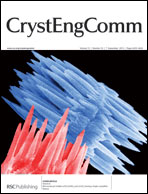A new conformational polymorph of N-acetyl-l-cysteine. The role of S–H⋯O and C–H⋯O interactions†
Abstract
A novel polymorph of ![[double bond, length as m-dash]](https://www.rsc.org/images/entities/char_e001.gif) C–CH3 hydrogen bonds, except that the COOH group is rotated by 180° in form II to make an auxiliary C–H⋯O interaction with the
C–CH3 hydrogen bonds, except that the COOH group is rotated by 180° in form II to make an auxiliary C–H⋯O interaction with the ![[double bond, length as m-dash]](https://www.rsc.org/images/entities/char_e001.gif) C–OH and N–H⋯S hydrogen bonds whereas the new form II has only N–H⋯S interactions. The conformational polymorphs of NAC were compared by Hirshfeld surface analysis (dnorm) and XPac methods, and were spectroscopically characterized by
C–OH and N–H⋯S hydrogen bonds whereas the new form II has only N–H⋯S interactions. The conformational polymorphs of NAC were compared by Hirshfeld surface analysis (dnorm) and XPac methods, and were spectroscopically characterized by


 Please wait while we load your content...
Please wait while we load your content...